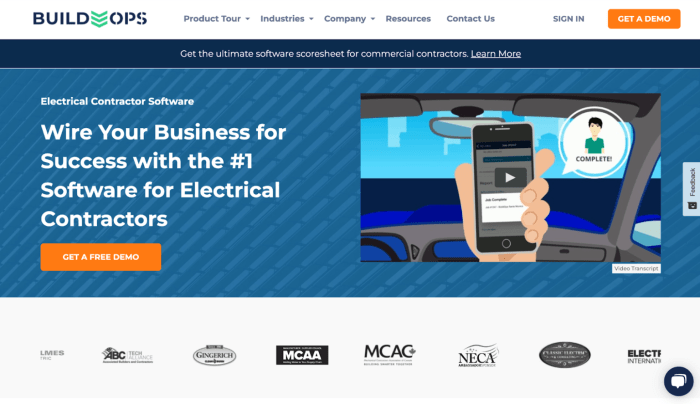Electrical contractor software is revolutionizing the industry, transforming how electrical contractors manage projects, teams, and finances. From streamlined bidding processes to automated scheduling and improved client communication, the right software can significantly boost efficiency and profitability. This deep dive explores the essential features, workflow optimizations, and financial management capabilities offered by leading electrical contractor software solutions, helping you navigate the complexities of choosing the perfect tool for your business.
This article will cover key aspects of electrical contractor software, including its core features, how it optimizes workflows, its role in managing clients and teams, its financial management capabilities, its contribution to safety and compliance, and finally, how to choose the right software for your specific needs. We’ll also compare popular options and offer practical advice to help you make an informed decision.
Software Features

Choosing the right software can significantly boost efficiency and profitability for electrical contractors. A robust system streamlines operations, from initial project estimations to final invoicing, minimizing errors and maximizing resource allocation. This section delves into the essential features of effective electrical contractor software.
Discover how Insulated Siding Key to Energy-Efficient Homes has transformed methods in this topic.
Core Functionalities
Essential functionalities in electrical contractor software typically include project management tools, client relationship management (CRM) features, estimating and bidding capabilities, inventory management, and time tracking. These core components work together to provide a comprehensive solution for managing all aspects of an electrical contracting business. Effective software will integrate these features seamlessly, eliminating the need for multiple disparate systems and reducing data entry redundancy.
Project Management Features
Different software solutions offer varying levels of sophistication in their project management features. Some may offer basic task assignment and scheduling, while others provide advanced features like Gantt charts for visual project tracking, resource allocation tools, and collaborative platforms for team communication. Advanced project management capabilities allow contractors to monitor progress in real-time, identify potential delays, and proactively adjust schedules to meet deadlines and client expectations.
For example, one system might allow for detailed sub-task creation within larger projects, while another might focus on streamlined task assignment and progress tracking via mobile app.
Reporting and Analytics Capabilities, Electrical contractor software
Leading electrical contractor software packages provide robust reporting and analytics dashboards. These tools offer valuable insights into project profitability, labor costs, material usage, and overall business performance. Detailed reports can be generated to track key performance indicators (KPIs), identify areas for improvement, and inform strategic decision-making. For instance, a contractor could analyze profitability by project type, identifying which projects are most and least lucrative, or track material costs to pinpoint areas of potential savings.
Integration with Other Business Tools
Seamless integration with other business tools is crucial for optimizing workflow. This includes integration with accounting software (like QuickBooks or Xero) for automated invoicing and financial reporting, CRM systems for managing client relationships, and payroll software for streamlined employee compensation. Such integration minimizes manual data entry, reduces errors, and provides a holistic view of the business’s financial health.
For example, automated data transfer between project management and accounting software can eliminate the need for manual data entry of project expenses and revenue.
Feature Comparison
Below is a comparison of five key features across three popular software options (fictional names used for illustrative purposes): ElectrifyPro, VoltFlow, and AmplifyMax.
| Feature | ElectrifyPro | VoltFlow | AmplifyMax |
|---|---|---|---|
| Project Management | Gantt charts, task assignment, resource allocation | Task management, progress tracking, basic scheduling | Gantt charts, resource allocation, real-time collaboration |
| Reporting & Analytics | Customizable reports, KPI tracking, financial dashboards | Basic reports, limited KPI tracking | Advanced analytics, predictive modeling, custom dashboards |
| Inventory Management | Real-time inventory tracking, automated ordering | Manual inventory tracking | Real-time tracking, automated ordering, low-stock alerts |
| CRM Integration | Seamless integration with major CRM platforms | Limited CRM integration | Seamless integration, automated client communication |
| Accounting Integration | Direct integration with QuickBooks and Xero | Manual data export/import | Automated data transfer, real-time financial updates |
Client and Team Management: Electrical Contractor Software

Streamlining client interactions and optimizing team workflows are crucial for any electrical contracting business. Efficient management translates directly to increased profitability and client satisfaction. This section details how specialized software can revolutionize these processes.
Effective client and team management software integrates various tools to enhance communication, track progress, and ultimately, deliver projects on time and within budget. This leads to happier clients and a more productive, less stressed workforce.
Client Information and Communication Management
Centralized client databases are a game-changer. The software should allow for easy storage and retrieval of all relevant client information, including contact details, project history, and communication logs. This eliminates the chaos of scattered spreadsheets and ensures everyone has access to the same, up-to-date information. Imagine instantly accessing a client’s complete history – from initial contact to final payment – with a single click.
This level of organization minimizes errors and improves response times.
Task Assignment and Employee Progress Tracking
Efficient task assignment is key to project success. The software should allow supervisors to assign tasks to specific team members, set deadlines, and monitor progress in real-time. Features like progress bars, automated notifications, and customizable dashboards provide a clear overview of project status. For example, a project manager can easily see which technicians are on schedule and which might require additional support.
This proactive approach prevents delays and keeps projects moving smoothly.
Facilitating Communication Between Field Technicians and Office Staff
Real-time communication is essential for seamless project execution. The software can incorporate features like integrated messaging systems, allowing field technicians to instantly update the office on project progress, material needs, or any unforeseen issues. This immediate feedback loop reduces misunderstandings and ensures everyone is on the same page. For instance, if a technician discovers a wiring issue, they can immediately notify the office, allowing for quick procurement of the necessary materials and preventing project delays.
Managing Employee Time and Attendance
Accurate time tracking is vital for payroll accuracy and project costing. The software can automate time sheet submission, eliminating manual data entry and reducing errors. Features like GPS tracking can verify technician location and working hours, further enhancing accuracy and accountability. This not only simplifies payroll but also provides valuable data for project budgeting and resource allocation. For example, accurate time tracking can reveal which projects are exceeding their allocated time, allowing for adjustments to future project planning.
Client Project Workflow
The following flowchart illustrates a typical client project workflow using the software:
Flowchart:
1. Client Inquiry/Request: New client requests are logged in the system, automatically assigning a unique project ID.
2. Project Initiation: Project details, including scope, budget, and timeline, are entered into the system. Tasks are assigned to team members.
3. Project Execution: Technicians use the software to track their progress, report on issues, and request materials. Real-time updates are visible to the office staff.
4. Progress Monitoring: The project manager uses the software’s dashboards to monitor progress, identify potential bottlenecks, and make adjustments as needed.
5. Completion and Invoicing: Upon project completion, the system automatically generates invoices based on tracked time and materials.
6. Client Feedback: The software facilitates client feedback collection, enabling continuous improvement and stronger client relationships.
Array
Staying compliant with electrical safety regulations isn’t just about avoiding hefty fines; it’s about protecting lives and ensuring the smooth operation of your business. Electrical work inherently carries significant risks, and robust safety protocols are paramount. This is where specialized software steps in, transforming the way electrical contractors manage safety, compliance, and ultimately, their bottom line.Software significantly enhances an electrical contractor’s ability to meet and maintain industry safety regulations.
By centralizing crucial safety information, automating tasks, and providing real-time insights, it minimizes the risk of human error and ensures consistent adherence to best practices. This leads to a safer work environment and a more efficient operation.
Safety Training and Documentation Management
Effective safety training is the cornerstone of a safe workplace. Software streamlines this process by allowing contractors to easily schedule, track, and manage employee training sessions. The system can automatically generate and distribute training materials, ensuring everyone receives the most up-to-date information. Furthermore, software provides a secure, centralized repository for all safety-related documentation, including certifications, permits, and training records, making audits easier and ensuring quick access to critical information when needed.
This eliminates the risk of misplaced or outdated documents, a common problem in many businesses.
Accident and Incident Prevention
Software equipped with robust safety features can actively help prevent accidents. For instance, a system can incorporate checklists for pre-job safety inspections, ensuring that critical safety steps are not overlooked. Real-time location tracking of employees and equipment can enhance situational awareness and prevent potential hazards, especially in large-scale projects. The software can also integrate with other systems to provide alerts and notifications about potential risks based on weather conditions, equipment malfunctions, or other relevant factors.
Imagine the system flagging a high-voltage line proximity warning before a crew begins excavation.
Safety Incident Reporting and Tracking
Efficient reporting and tracking of safety incidents are vital for identifying trends, improving safety procedures, and demonstrating compliance. Software facilitates this by providing a streamlined process for reporting incidents, including detailed descriptions, photographs, and witness statements. The system can automatically generate reports, analyze incident data to identify recurring problems, and track corrective actions taken to prevent future occurrences. This data-driven approach allows contractors to proactively address safety concerns and continuously improve their safety performance.
Software Preventing a Safety Hazard: A Case Study
Imagine a scenario where an electrical contractor is working on a high-rise building. Using specialized software, the team inputs the location of all electrical components and cabling into the system. Before starting work on a specific floor, the software cross-references the planned work with the existing electrical layout, highlighting a potential conflict: a section of cabling was not properly documented and was located near the planned work area.
This near-miss, identified by the software, allowed the team to re-evaluate their plan, avoid potential electrocution hazards, and ultimately prevent a serious accident. The software’s ability to cross-reference data and highlight inconsistencies proved crucial in this scenario.
Ultimately, investing in the right electrical contractor software is an investment in your business’s future. By streamlining operations, improving communication, and enhancing financial management, you can achieve greater efficiency, increased profitability, and enhanced client satisfaction. Don’t just manage your electrical contracting business—elevate it with the power of technology. Choosing the right software is a crucial step towards achieving sustainable growth and success in a competitive market.
Remember to carefully consider your specific needs and explore available options before making a decision.
FAQ Resource
What is the average cost of electrical contractor software?
The cost varies greatly depending on features, scalability, and vendor. Expect to pay anywhere from a few hundred dollars annually for basic plans to several thousand for comprehensive solutions with extensive support.
How long does it take to implement electrical contractor software?
Implementation time depends on the software’s complexity and your team’s familiarity with technology. Simple systems might take a few days, while more complex ones could require weeks or even months.
Can electrical contractor software integrate with my existing accounting software?
Many software options offer integrations with popular accounting platforms like QuickBooks and Xero, streamlining data flow and reducing manual data entry.
What kind of training is available for electrical contractor software?
Most vendors provide training resources, including online tutorials, webinars, and dedicated customer support. The level of training offered varies depending on the software package.
Is cloud-based electrical contractor software more secure than on-premise solutions?
Cloud-based software often benefits from robust security measures implemented by the vendor, but both options have security risks. Choose a reputable vendor with strong security protocols, regardless of the deployment model.